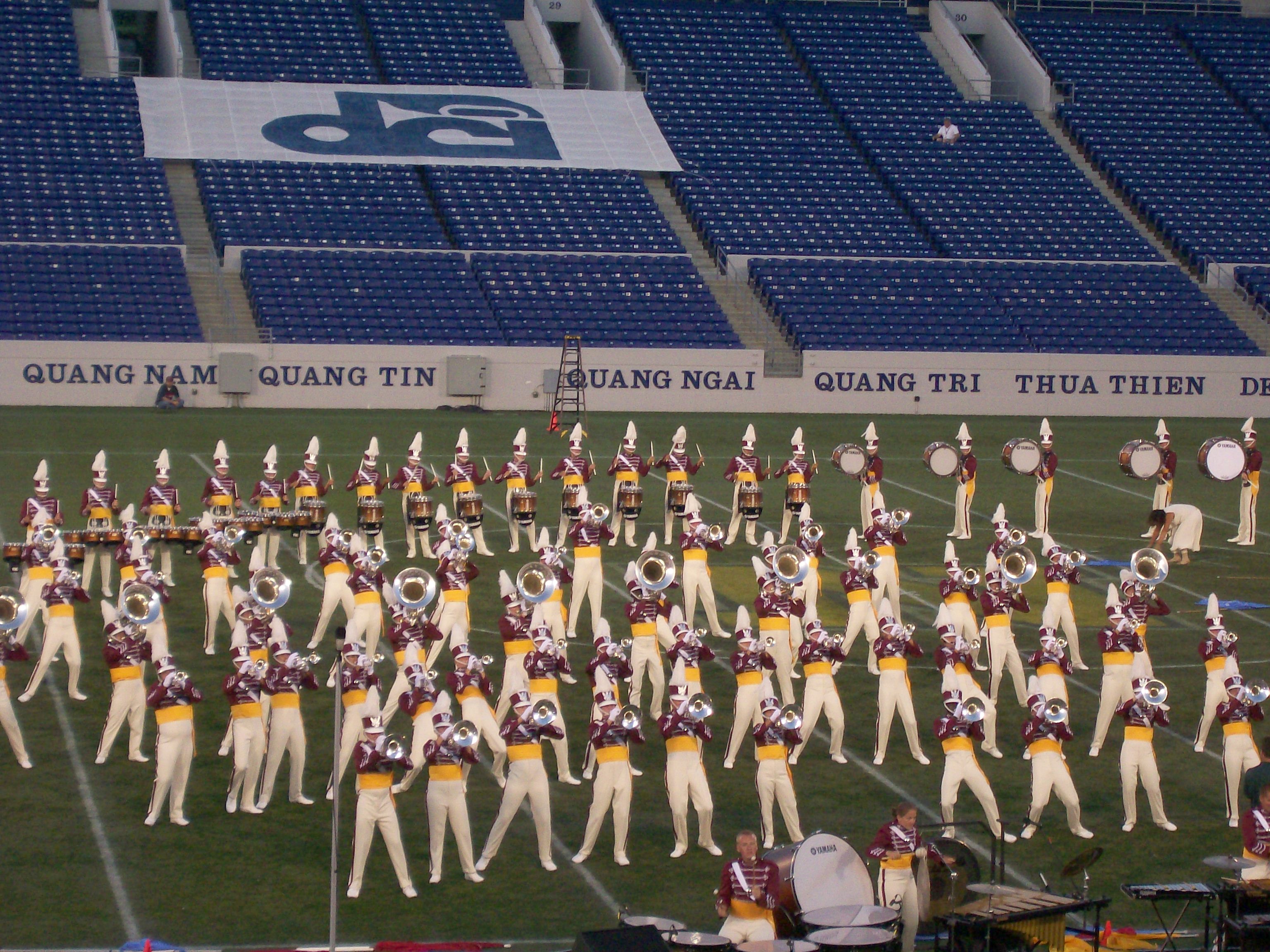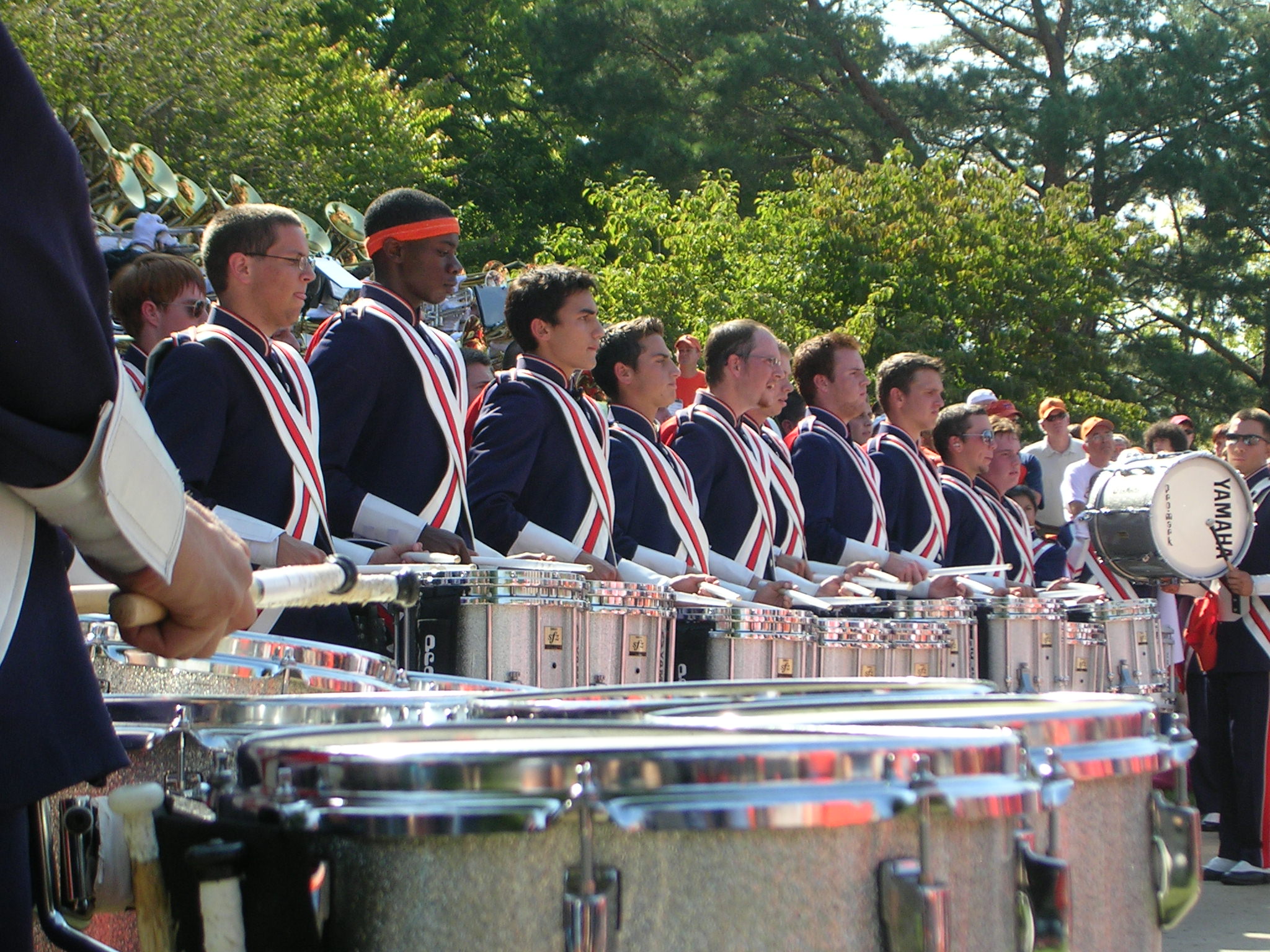|
Ankle Knee Step
The ankle knee step is a type of high step used by marching bands. It is named such because when executed properly, the ankle of one leg should be at the height of the knee of the other leg. This step is chiefly used by marching bands which consider themselves traditional or show style bands, although drum corps and corps-style marching bands may use this step sparingly for effect. When performed, the toe should be the last part of the foot to leave the ground and the first part to hit it again. Although the step is a dynamic movement, care should be taken to step smoothly so as not to interrupt the air flow of wind instrumentalists. As the glide step rolls the foot from the heel to the toe, marchers executing the ankle knee step roll the foot from the toe to the heel. The entire step is a fluid motion; execution should be in time such that the "up" position is reached on the "and" counts and the "down" position is on the "down" counts. The foot comes forward in a scooping action r ... [...More Info...] [...Related Items...] OR: [Wikipedia] [Google] [Baidu] |
Marching Band
A marching band is a group of instrumental musicians who play while marching. Historically they were used in armed forces and many marching bands remain military bands. Others are still associated with military units or emulate a military style, with elements such as uniforms, flags and batons and occasionally rifles or sabers. Instrumentation typically includes brass, woodwind, and percussion instruments. Marching bands are generally categorised by affiliation, function, size and instrumentation. In addition to traditional military parades, marching bands are frequently seen at events as varied as carnivals, parades, sporting events, trade union events and marching band competitions. History Instruments have been frequently used on the battlefield (for example the Iron Age carnyx and the medieval Ottoman military band) but the modern marching band developed from European military bands formed in the Baroque period, partly influenced by the Ottoman tradition. 17th ... [...More Info...] [...Related Items...] OR: [Wikipedia] [Google] [Baidu] |
Ankle
The ankle, the talocrural region or the jumping bone (informal) is the area where the foot and the leg meet. The ankle includes three joints: the ankle joint proper or talocrural joint, the subtalar joint, and the inferior tibiofibular joint. The movements produced at this joint are dorsiflexion and plantarflexion of the foot. In common usage, the term ankle refers exclusively to the ankle region. In medical terminology, "ankle" (without qualifiers) can refer broadly to the region or specifically to the talocrural joint. The main bones of the ankle region are the talus bone, talus (in the foot), the tibia, and fibula (both in the leg). The talocrural joint is a Synovial joint, synovial hinge joint that connects the distal ends of the tibia and fibula in the lower limb with the proximal end of the talus. The articulation between the tibia and the talus bears more weight than that between the smaller fibula and the talus. Structure Region The ankle region is found at the junction ... [...More Info...] [...Related Items...] OR: [Wikipedia] [Google] [Baidu] |
Knee
In humans and other primates, the knee joins the thigh with the leg and consists of two joints: one between the femur and tibia (tibiofemoral joint), and one between the femur and patella (patellofemoral joint). It is the largest joint in the human body. The knee is a modified hinge joint, which permits flexion and extension (kinesiology), extension as well as slight internal and external rotation. The knee is vulnerable to injury and to the development of osteoarthritis. It is often termed a ''compound joint'' having tibiofemoral and patellofemoral components. (The fibular collateral ligament is often considered with tibiofemoral components.) Structure The knee is a modified hinge joint, a type of synovial joint, which is composed of three functional compartments: the patellofemoral articulation, consisting of the patella, or "kneecap", and the patellar groove on the front of the femur through which it slides; and the medial and lateral tibiofemoral articulations linking the ... [...More Info...] [...Related Items...] OR: [Wikipedia] [Google] [Baidu] |
Drum And Bugle Corps (modern)
A modern drum and bugle corps is a musical marching unit consisting of brass instruments, percussion instruments, Electronic musical instrument, electronic instruments, and Color guard (flag spinning), color guard. Typically operating as independent non-profit organizations, corps perform in competitions, parades, festivals, and other civic functions. Participants of all ages are represented within the corps activity, but the majority are between the ages of 13 and 22 and are members of corps within Drum Corps International. Competitive summer drum corps participate in summer touring circuits, such as Drum Corps International, Drum Corps International (DCI) and Drum Corps Associates, Drum Corps Associates (DCA). Corps prepare a new show each year, approximately 8–12 minutes in length, and refine it throughout the summer tour. Shows are performed on American football, football fields and are judged in various musical and visual categories, or "captions". Musical repertoires vary ... [...More Info...] [...Related Items...] OR: [Wikipedia] [Google] [Baidu] |
Glide Step
The glide step or roll step is a form of movement used by marching bands to minimize upper body movement, enabling musicians to play their instruments and march without air-stream interruptions. Standardizing the style of marching also serves to add to the visual effect of a marching band. Sometimes special shoes are worn with a curved heel that facilitates rolling the foot. Glide stepping is used by many high school and college marching bands, and by many drum corps.Colwell, R., Hewitt, M. (2017). The Teaching of Instrumental Music. United Kingdom: Taylor & Francis. Pg 145. Technique Glide step seeks to restrict all motion above the upper-body to a smooth, unchanging motion in the direction of travel, and to restrict all motion below the waist to that which is completely necessary. Before the glide step can be learned, the general posture of the body must be normalized. This is called "attention". The important aspects of attention for marching are having a tall, ... [...More Info...] [...Related Items...] OR: [Wikipedia] [Google] [Baidu] |
Heel
The heel is the prominence at the posterior end of the foot. It is based on the projection of one bone, the calcaneus or heel bone, behind the articulation of the bones of the lower leg. Structure To distribute the compressive forces exerted on the heel during gait, and especially the stance phase when the heel contacts the ground, the sole of the foot is covered by a layer of subcutaneous connective tissue up to 2 cm thick (under the heel). This tissue has a system of pressure chambers that both acts as a shock absorber and stabilises the sole. Each of these chambers contains fibrofatty tissue covered by a layer of tough connective tissue made of collagen fibers. These septa ("walls") are firmly attached both to the plantar aponeurosis above and the sole's skin below. The sole of the foot is one of the most highly vascularized regions of the body surface, and the dense system of blood vessels further stabilize the septa. The Achilles tendon is the muscle tendon of t ... [...More Info...] [...Related Items...] OR: [Wikipedia] [Google] [Baidu] |
Marching 100
The marching band at Florida A&M University is commonly and widely known as the "Marching 100" or simply "The 100." Since its inception, the band has been credited with 30 innovative techniques that have become standard operating procedures for many high school and collegiate marching band programs. History The first band at FAMU was organized in 1892, under Phillip Amos von Weller. In 1946, when William P. Foster was selected as director of bands, there were only 16 members. Since then, the band has grown to as many as over 400 members. The band has performed at the Super Bowl (on several occasions), the Summer Olympics, the inaugural parades for U.S. presidents Bill Clinton and Barack Obama, and was selected in 1989 as the official United States representative in the Bicentennial Celebration of the French Revolution in Paris, France. The band has also been featured as the opening act for the Louis Vuitton's men's fashion show at the Louvre during the 2022 Paris Fashion We ... [...More Info...] [...Related Items...] OR: [Wikipedia] [Google] [Baidu] |
Human Jukebox
The Human Jukebox is the marching band representing Southern University and A&M College located in Baton Rouge, Louisiana. Band Profile T. Leroy Davis is credited with establishing Southern University's marching band and served as the band director between 1947 and 1964. He also helped organize the first Southern University Band Festival and Band Day and was well-known for his contributions and achievements in music. Davis was given the title of Professor Emeritus for his many years of service to the university in 1989. The band is anchored by the Isaac Greggs Band Hall on campus. Dr. Isaac Greggs (Doc) was an award-winning band director and alumnus of Southern University that led the band for 36 years (1969 - 2005). Under his leadership, the band grew in popularity and established a distinctive identity. In addition to having the band hall renamed in his honor, he was inducted into the Louisiana Black History Hall of Fame in 2013 and had a display case dedicated in his hono ... [...More Info...] [...Related Items...] OR: [Wikipedia] [Google] [Baidu] |
Grambling State University
Grambling State University (GSU, Grambling, or Grambling State) is a public historically black university in Grambling, Louisiana, United States. Grambling State is home of the Eddie G. Robinson Museum and is listed on the Louisiana African American Heritage Trail. Grambling State is a member-school of the University of Louisiana System and Thurgood Marshall College Fund. Grambling State's athletic teams compete in Division I of the National Collegiate Athletic Association and are known as the Grambling State Tigers. Grambling State is a member of the Southwestern Athletic Conference. History Grambling State University developed from the desire of African-American farmers in rural north Louisiana who wanted to educate other African Americans. In 1896, the North Louisiana Colored Agriculture Relief Association led by Lafayette Richmond was formed to organize and operate a school. After opening a small school west of what is now the town of Grambling, the Association reque ... [...More Info...] [...Related Items...] OR: [Wikipedia] [Google] [Baidu] |
Marching Illini
The Marching Illini is the marching band of the University of Illinois Urbana-Champaign. The Marching Illini is an organization which annually includes approximately 400 students enrolled in the University of Illinois, and Parkland College (United States), Parkland College. It was founded in 1868 and primarily performs at Illinois Fighting Illini football, Illini football games as well as other events around campus. The band is a part of the University of Illinois College of Fine and Applied Arts, College of Fine and Applied Arts and Illinois Fighting Illini, Illini Athletics, and has diverse member participation from most colleges, disciplines and majors on the university's campus. History Early history The first marching band unit of record at the University of Illinois Urbana-Champaign was during the first year of classes in the fall of 1867. This was a group that consisted of a tenor drum, bass drum and fife. In January 1869, these three members were joined by several bras ... [...More Info...] [...Related Items...] OR: [Wikipedia] [Google] [Baidu] |
Eastern Michigan University Marching Band
The Eastern Michigan University Marching Band (The Pride of the Peninsula) serves as Eastern Michigan University's marching band. History The band was first formed in 1894, however the marching band was only a student-funded extra-curricular activity that performed in parades, concerts, and athletic events, it wasn't until 1924 that the band was officially recognized as an ensemble within the Normal Conservatory of Music due to the efforts of Normal Mathematics Professor J.F. Barnhill. Professor Barnhill brought Captain Wilfred Wilson, conductor of the Michigan Band, to the Ypsilanti campus as the first Director of the marching band. The first recorded mention of the “Huron Band” was on October 31, 1925, when 48 uniformed bandmen paraded the streets of Ypsilanti and later played at the Normal-Kalamazoo College football game. In 1964, Thomas Tyra was appointed director of bands at the university and in 1968, Max Plank joined the EMU Bands program as Tyra's assistant. Togethe ... [...More Info...] [...Related Items...] OR: [Wikipedia] [Google] [Baidu] |






